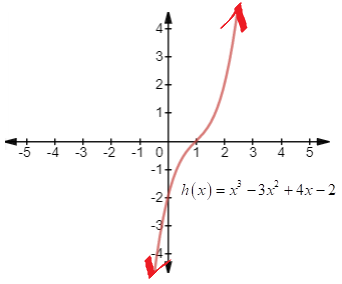
Concept explainers
To write : the polynomial as the product of linear factors and list all the zeros of function
Answer to Problem 68E
The function as product of linear factors:
The zeros of the function are:
Explanation of Solution
Given information:
Concept Involved:
Linear Factorization Theorem:If
Complex Zeros Occur in Conjugate Pairs: Let f be a polynomial function that has real coefficients. If
Synthetic Division (for a Cubic Polynomial):To divide
| In case when we have a polynomial with a missing term, insert placeholders with zero coefficients for missing powers of the variable. Vertical pattern: Add terms in columns Diagonal pattern: Multiply results by k. This algorithm for synthetic division works only for divisors of the form x - k. Remember that |
The Division Algorithm: If
Graph:

Interpretation:
From the graph of the function we can pick possible zeros of the function as
Calculation:
Use synthetic division to find the other zeros of the function
If
To find other zeros of the polynomial
We can solve this equation using completing the square method by subtracting 2 on both sides of the equation
Simplify on both sides of the equation
In order to make the left side expression as perfect square trinomial, we need to add square of half of coefficient of x on both sides
Simplify on right side of the equation
Write the left side as a perfect square
Take square root on both sides
Simplifying square root on both sides of the equation
Replace
Add 1 on both sides of the equation
Simplify in left side of the equation
List the zeros of the functions given:
If
So
Write the function
Conclusion:
The zeros of the given function
The function written as product of linear factors:
Chapter 2 Solutions
EBK PRECALCULUS W/LIMITS
- 4. Evaluate the following integrals. Show your work. a) -x b) f₁²x²/2 + x² dx c) fe³xdx d) [2 cos(5x) dx e) √ 35x6 3+5x7 dx 3 g) reve √ dt h) fx (x-5) 10 dx dt 1+12arrow_forwardI just need help with evaluating these limits.arrow_forward3. Differentiate the following functions. Show your work where applicable. a) y = e³x b) f(x)=2 cos(5x) c) y = 1 - 2 d) y = In|secx| e) f(t) = t² e√t f) f(x) = 1+x x sin x 3arrow_forward
- Rylee's car is stuck in the mud. Roman and Shanice come along in a truck to help pull her out. They attach one end of a tow strap to the front of the car and the other end to the truck's trailer hitch, and the truck starts to pull. Meanwhile, Roman and Shanice get behind the car and push. The truck generates a horizontal force of 377 lb on the car. Roman and Shanice are pushing at a slight upward angle and generate a force of 119 lb on the car. These forces can be represented by vectors, as shown in the figure below. The angle between these vectors is 20.2°. Find the resultant force (the vector sum), then give its magnitude and its direction angle from the positive x-axis. 119 lb 20.2° 377 lbarrow_forwardAn airplane flies due west at an airspeed of 428 mph. The wind blows in the direction of 41° south of west at 50 mph. What is the ground speed of the airplane? What is the bearing of the airplane?arrow_forwardA vector with magnitude 5 points in a direction 190 degrees counterclockwise from the positive x axis. Write the vector in component form, and show your answers accurate to 3 decimal places.arrow_forward
 Calculus: Early TranscendentalsCalculusISBN:9781285741550Author:James StewartPublisher:Cengage Learning
Calculus: Early TranscendentalsCalculusISBN:9781285741550Author:James StewartPublisher:Cengage Learning Thomas' Calculus (14th Edition)CalculusISBN:9780134438986Author:Joel R. Hass, Christopher E. Heil, Maurice D. WeirPublisher:PEARSON
Thomas' Calculus (14th Edition)CalculusISBN:9780134438986Author:Joel R. Hass, Christopher E. Heil, Maurice D. WeirPublisher:PEARSON Calculus: Early Transcendentals (3rd Edition)CalculusISBN:9780134763644Author:William L. Briggs, Lyle Cochran, Bernard Gillett, Eric SchulzPublisher:PEARSON
Calculus: Early Transcendentals (3rd Edition)CalculusISBN:9780134763644Author:William L. Briggs, Lyle Cochran, Bernard Gillett, Eric SchulzPublisher:PEARSON Calculus: Early TranscendentalsCalculusISBN:9781319050740Author:Jon Rogawski, Colin Adams, Robert FranzosaPublisher:W. H. Freeman
Calculus: Early TranscendentalsCalculusISBN:9781319050740Author:Jon Rogawski, Colin Adams, Robert FranzosaPublisher:W. H. Freeman
 Calculus: Early Transcendental FunctionsCalculusISBN:9781337552516Author:Ron Larson, Bruce H. EdwardsPublisher:Cengage Learning
Calculus: Early Transcendental FunctionsCalculusISBN:9781337552516Author:Ron Larson, Bruce H. EdwardsPublisher:Cengage Learning





